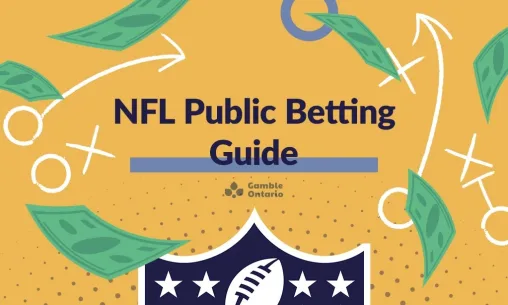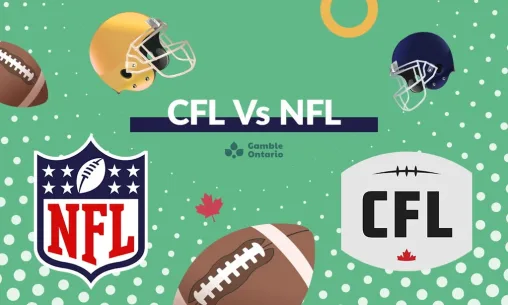How Many NFL Teams Make the Playoffs in 2025?
If you’re gearing up for the NFL playoffs and want a breakdown of how it all works, this guide has you covered.
As fans in Ontario prepare to follow the action, here’s everything you need to know—from the number of teams and playoff format to betting tips tailored for Ontario fans.
Here’s what I included οn this page:
🏈 How many NFL teams are there in 2024 – A quick look at the league’s structure and its 32 t
🏈 NFL playoffs format 2024-2025 – A detailed breakdown of the seeding, Wild Card round, and Divisional Round.
🏈 How the NFL playoffs work – A step-by-step guide on how teams advance through the playoffs.
🏈 NFL playoff bracket for 2024 – Insights into how the bracket works and why it’s so unpredictable.
🏈 NFL Wild Card round 2025 – An overview of the exciting first round of the playoffs.
🏈 The best NFL betting sites’ tips for Ontario fans – Helpful strategies for betting during the postseason.

🏆 How Many NFL Teams Are There in 2025?
The NFL remains strong with 32 teams in 2024, split evenly between the AFC and NFC conferences.
As someone who’s followed the league for years (and sat through more nail-biting games than I care to count), I can tell you that each team brings its own flair and drama.
With 16 teams in each conference, these squads are further divided into four divisions (North, South, East, and West), creating matchups that are not only crucial but also legendary.
For us in Ontario, teams like the Buffalo Bills—just a stone’s throw away from the border—are naturally fan favourites.
I’ve followed them closely for years, and it’s been a wild ride watching the AFC East go from Patriots domination to the Bills emerging as true contenders.
Rivalries like these, between teams like the Bills, Patriots, Dolphins, and Jets, add an extra layer of excitement every year.
🆚 How Many Teams Make the NFL Playoffs in 2024-2025?
In the 2024-2025 season, 14 teams will make the playoffs—7 from the AFC and 7 from the NFC.
With this expanded format, introduced in 2020, the race to the Super Bowl has become even more exciting.
The top seed in each conference gets a first-round bye, while the remaining six teams compete in the Wild Card round for a spot in the divisional playoffs.
I’ll never forget when this new format first came into play. The 2020 Kansas City Chiefs and San Francisco 49ers got the coveted byes, only to meet in an unforgettable Super Bowl clash. This format has led to some amazing Cinderella stories too.
Remember when the 2022 New York Giants, who hadn’t seen the playoffs in years, upset the Minnesota Vikings in the Wild Card?
Moments like that are what make playoff football so captivating.
What I love most is the unpredictability. Wild Card teams can—and do—go all the way, like the 2007 New York Giants or the 2010 Green Bay Packers, both of whom won the Super Bowl after entering the playoffs as lower seeds.
More teams, more surprises, more reasons to watch every game like it’s the Super Bowl.
💡How Do the NFL Playoffs Work?
The NFL playoffs are all about win-or-go-home action. The 14 teams are seeded based on their regular-season records, with the No. 1 seed from each conference earning a first-round bye.
The remaining teams, seeded 2 through 7, battle it out in the Wild Card round. Think of it like this: No. 2 plays No. 7, No. 3 faces No. 6, and No. 4 squares off against No. 5.
Once we’re through the Wild Card, the divisional playoffs begin, and this is where the top seed re-enters the fray, facing off against the lowest remaining seed.
From my years of watching and writing NFL live commentaries, this is where anything can happen—teams that rest during the bye can either dominate or falter.
We’ve seen both! Take the 2021-2022 season, when the top-seeded Titans and Packers were both upset after their byes. It’s a reminder that in the playoffs, nothing is guaranteed.
⭐ The NFL Playoff Bracket for 2025
For the 2025 season, the playoff bracket follows the same exciting format, with 14 teams fighting for the Lombardi Trophy.
One of my favourite parts of the playoff season is filling out a bracket. Whether you’re betting or just doing it for fun with friends, it adds another layer of excitement for NFL playoffs.
The unpredictability of the NFL means your picks might get blown up after the first round (it’s happened to me more than once!). But that’s what makes it fun.
You might see teams like the Chiefs, 49ers, Lions, or Ravens leading the pack, but there’s always the chance for a shocking upset. A Wild Card team could go on an improbable run and steal the show. That’s why I love the NFL playoffs—anything can happen.

🚀 NFL Playoff Betting Tips for Ontario Fans
Betting on the NFL playoffs isn’t like betting on regular-season games. The stakes are higher, the teams are more finely tuned, and the odds are tighter.
After years of writing betting reviews during the NFL playoff season, here are a few tips I’ve picked up:
✔️ Do Your Research: It’s all about matchups. Playoff games often come down to a team’s strengths and weaknesses, so look at things like how a defence holds up against the run or how a quarterback performs under pressure.
✔️ Home Field Advantage MattersL In the playoffs, the energy in these stadiums is wild, and home teams usually have the upper hand. I’ve underestimated home-field advantage before, only to watch the home team ride the crowd’s energy to victory.
✔️ First Halves Are Tight: Playoff teams tend to feel each other out early, and defences step up. Betting on a low-scoring first half can be a smart move.
✔️ Lock in Futures Early: If you like a team’s chances, get your futures bets in early before the odds shift. I made a solid bet on the Rams in 2022 after they dominated their Wild Card game—before their odds dropped later in the playoffs.
Every year, no matter how much you’ve followed teams or tracked stats, the playoffs have a way of surprising us all.
For the 2024-2025 season, I’ll be glued to my TV every weekend, tracking how each round unfolds. I’ll be watching closely to see which teams show that extra playoff gear, the kind that separates good teams from championship-calibre ones. The beauty of playoff football is that it’s not always the best team that wins, but the team that gets hot at the right time.
Whether it’s setting up a playoff bracket with your friends, placing a few well-researched bets, or simply keeping up with the latest storylines, there’s so much to get excited about.
And remember, the NFL season is long, but the playoffs fly by. From the moment the Wild Card games kick-off to the confetti falling at the Super Bowl, it’s a rollercoaster.
❓ Our Readers’ Questions About NFL Teams
How many teams make the NFL playoffs 2025?
In the 2025 NFL playoffs, a total of 14 teams will qualify. This includes 7 teams from the AFC and 7 from the NFC. The playoff format features four division winners and three Wild Card teams from each conference.
The No. 1 seed in each conference earns a first-round bye, while the other six teams play in the Wild Card round.
How many teams make the NFL playoffs bracket?
The NFL playoff bracket consists of 14 teams in total—7 from the AFC and 7 from the NFC.
These teams are seeded based on their regular season records. The bracket structure starts with the Wild Card round, where the No. 2 seed plays the No. 7 seed, No. 3 plays No. 6, and No. 4 plays No. 5 in both conferences.
The winners then advance to the Divisional Round.
How many teams make the Wild Card in football?
In the NFL, 6 teams total—3 from the AFC and 3 from the NFC—will make the NFL wildcard round 2025.
These teams are the top non-division winners in their respective conferences based on their regular season records. Wild Card teams are typically seeded 5th through 7th, and they play against the lower-seeded division winners in the first round of the playoffs.
What NFL team has made it to the playoffs the most?
As of 2025, the Dallas Cowboys and Green Bay Packers hold the record for the most playoff appearances in NFL history, with 36 playoff appearances.
They are followed closely by the Pittsburgh Steelers (34) and New York Giants (33).
🔏 How We Ensure the Accuracy of Our Information
To ensure that the information in this NFL playoff team guide is accurate and up-to-date, I cross-checked multiple authoritative sources.
By referencing these trusted sources, I ensure that the content is both reliable and relevant for NFL fans, particularly those in Ontario.
These sources include:
- NFL Official Website: Provides the most direct and up-to-date information regarding the playoff structure, team standings, and official game schedules.
- Sporting News: Detailed coverage of the NFL playoff format, seeding rules, and how the playoffs have evolved since the expansion in 2020.
- Pro Football Network: Explains how the NFL playoffs work, including seeding, tie-breaking procedures, and the importance of home-field advantage.
- DAZN: Offers a thorough breakdown of the NFL playoff format, including the expanded 14-team structure and its impact on the competition.
Our Most-Viewed NFL Articles in July 2025
Rowan is a highly accomplished sports betting journalist with a proven track record of over 6 years in the sports media industry. He is widely recognized for his insightful coverage and thought-provoking commentary on major leagues like the NBA, NFL, and NCAA.


















